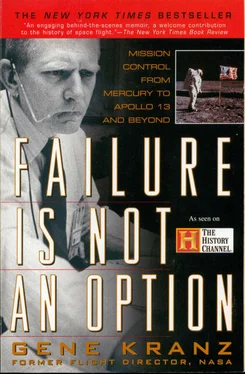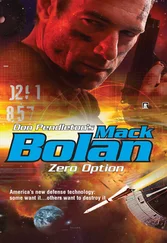There was, of course, a remarkable sequel to Glenn’s flight. He retired from the astronaut corps to run for the Senate, withdrawing once after an accident, losing a second race to big money, and getting elected on his third try. No one ever accused John Glenn of being a quitter. He served in the Senate, representing Ohio, then retired after four terms. Thirty-six years after he had made space history he flew again, this time on the Space Shuttle in October 1998. His second flight helped close the chapters in history books that cover the first four decades of America’s space program.
Langley Air Force Base, Virginia
By the time of John Glenn’s flight, time was our greatest enemy at NASA. We had to move ahead as quickly as possible because of President Kennedy’s pledge to land a man on the Moon in the 1960s; we also knew that nasty surprises awaited us at every stage in development, no matter how hard we tried to anticipate the most remote contingencies.
Deke Slayton had been selected to fly the second orbital Mercury mission. I had quickly updated the rules based on the Glenn mission and, with the flight planners, was set to give Deke an advance look at the flight rules and the five experiments that had been added. The same scientists who had believed a man’s performance in space would be severely degraded by zero gravity and other factors were now eager to have astronauts perform as many experiments as possible, within the limits of a three-orbit mission. Deke had heard the experiments were coming and voiced his well-founded objections to anyone who would listen. I believed he was right to do so. With only three orbits’ worth of manned experience, most, if not all, of the team felt it was too soon to distract the astronaut with tethered balloons, fluid studies, and a variety of other observations.
I was pulling together a one-page cheat sheet for Slayton on the flight rules, when the word came down that he would be replaced by Scott Carpenter. This news shocked us all, although not nearly as much as it did Deke. I assumed the switch was because he had raised hell about all the added experiments.
But it turned out that Slayton had been scratched because of an irregular heartbeat. The problem, known as idiopathic atrial fibrillation, had been noted when Deke was being tested on the centrifuge (which simulated increased gravity and other stress factors). After an analysis of his data by NASA and Air Force specialists, he was accepted for flight. When it was his turn to fly, the NASA Administrator, James Webb, had his records reviewed for a final time. Three different groups of medical specialists gave their okay—then Webb got three civilian cardiologists from Georgetown University, Washington Hospital Center, and the National Institutes of Health to review his records and give him a brief exam. They recommended his removal from flight status. Moral: if you ask enough people, you’ll find someone who will disagree with the majority and give those nervous about risk a way out. No one doubted Deke’s heart when he was one of the hot test pilots at Edwards Air Force Base, pushing the F-105 to its limits.
Slayton didn’t quit the program. Few expected that he would. His initial assignment placed him as coordinator of the astronaut corps, and his first task involved the selection of the second class of astronauts. In October 1963 he was named the deputy for flight operations, putting him in charge of just about everything that concerned his fellow astronauts. It was a legitimate job and a big one, but you could not avoid suspecting that Deke had been given a consolation prize.
In the trenches at Mercury Control, we probably felt the strongest empathy for him, and for the time and energy he had spent training for a day that was now gone from the calendar and might never come again. He would be cleared ten years later and would finally make it into space as part of NASA’s joint venture with the Russians. But for now, he was the first of the Mercury astronauts to be washed out, and the controllers could not view that setback with indifference.
Scott Carpenter, the backup for Glenn’s mission, was a virtual unknown to most of the controllers. When Scott was given the nod, we were surprised because we had been expecting Wally Schirra, Slayton’s backup, to replace Deke. The mission was rescheduled to accommodate the change in crewman, and additional attitude control tests were added to the flight plan. Glenn’s mission had finally cleared the way for astronauts having hands-on control of the spacecraft in flight. John had not experienced any disorientation, and his troubleshooting of the attitude control problems demonstrated the value of having a human in control of the spacecraft at critical moments. Carpenter’s flight plan was expanded to permit him to perform maneuvers to observe sunrise and sunset, fly upside down to test pilot disorientation, and conduct visual observations of Earth and space phenomena.
We had reached another milestone; two teams were working in concert, more or less, the man in the capsule and the crews in the control room. Both sides were—understandably—a little wary of the scientists.
Now the earthbound Slayton had nearly as much in common with our Flight Control team as his own astronaut corps. We in Mercury Control were like the second-string team in football, who scrimmaged all week and took the banging, but didn’t get to make the road trips. Each time a rocket lifted off the pad, we felt pride and elation… and a little envy.
We did not mingle socially with the astronauts. Even if that had seemed a desirable thing to do, none of us had the time. When the astronauts were not in nearly nonstop training, they were flying or racing their sports cars or making public appearances to promote the space program. But as our Mercury Control team acquired as much, if not more, knowledge about the spacecraft as those who would fly them, each mission brought both sides closer together in mutual confidence—and we felt a more personal link with the crews.
The first Mercury orbital mission had been at the core of our lives in the winter of 1961. Now, in the early months of 1962, Gilruth’s newly designated Manned Spacecraft Center was moving to Houston amid a massive reorganization. This new NASA center was charged with the design, development, and flight operations for the newly formed Gemini and Apollo programs. In July 1960 NASA had announced plans to follow Mercury with a program to fly to the Moon. The program was subsequently called Apollo. The Gemini Program, which started in 1961, would bridge the technology gap between the Mercury missions and the far more ambitious Apollo lunar program. In 1962 the MSC was in a period of unprecedented growth and change. It departed the Langley Field facilities with a staff of 750. With the staff more than doubling each year it would increase to 6,000 at the beginning of Gemini operations in 1964. This rapid growth necessitated corresponding changes in the Flight Operations Division. Chuck Mathews, the FOD division chief, was reassigned by Gilruth to form a Spacecraft Research Division to develop the design requirements and the technologies needed for the Gemini and Apollo spacecraft. Chris Kraft replaced Mathews as the FOD chief. John Hodge, the Bermuda flight director, then formed a Flight Control Operations Branch. This branch had the responsibility for the mission rules development and the remote site teams and the MCC systems controllers. Hodge selected me as deputy chief. My role as his deputy did not last long. Two months later Kraft selected Hodge as his assistant, and I became the branch chief for Flight Control Operations. I now had the resources I needed to develop an operations team that was fully capable of taking any actions needed during the course of a mission.
Читать дальше












